Related Research Articles
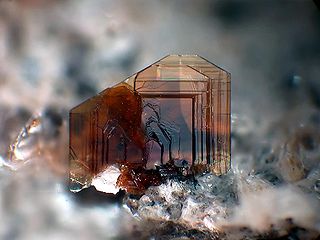
Biotite is a common group of phyllosilicate minerals within the mica group, with the approximate chemical formula K(Mg,Fe)
3AlSi
3O
10(F,OH)
2. It is primarily a solid-solution series between the iron-endmember annite, and the magnesium-endmember phlogopite; more aluminous end-members include siderophyllite and eastonite. Biotite was regarded as a mineral species by the International Mineralogical Association until 1998, when its status was changed to a mineral group. The term biotite is still used to describe unanalysed dark micas in the field. Biotite was named by J.F.L. Hausmann in 1847 in honor of the French physicist Jean-Baptiste Biot, who performed early research into the many optical properties of mica.
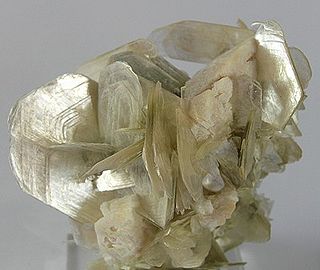
Muscovite (also known as common mica, isinglass, or potash mica) is a hydrated phyllosilicate mineral of aluminium and potassium with formula KAl2(AlSi3O10)(F,OH)2, or (KF)2(Al2O3)3(SiO2)6(H2O). It has a highly perfect basal cleavage yielding remarkably thin laminae (sheets) which are often highly elastic. Sheets of muscovite 5 meters × 3 meters (16.5 feet × 10 feet) have been found in Nellore, India.

Hornblende is a complex inosilicate series of minerals. It is not a recognized mineral in its own right, but the name is used as a general or field term, to refer to a dark amphibole. Hornblende minerals are common in igneous and metamorphic rocks.

Amphibole is a group of inosilicate minerals, forming prism or needlelike crystals, composed of double chain SiO
4 tetrahedra, linked at the vertices and generally containing ions of iron and/or magnesium in their structures. Its IMA symbol is Amp. Amphiboles can be green, black, colorless, white, yellow, blue, or brown. The International Mineralogical Association currently classifies amphiboles as a mineral supergroup, within which are two groups and several subgroups.
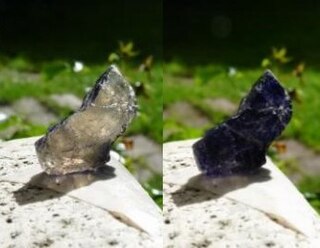
Pleochroism is an optical phenomenon in which a substance has different colors when observed at different angles, especially with polarized light.
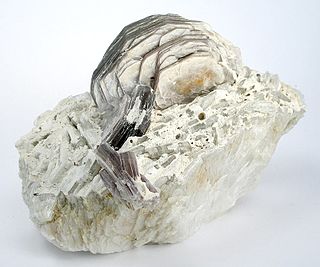
Lepidolite is a lilac-gray or rose-colored member of the mica group of minerals with chemical formula K(Li,Al)3(Al,Si,Rb)4O10(F,OH)2. It is the most abundant lithium-bearing mineral and is a secondary source of this metal. It is the major source of the alkali metal rubidium.

Epidote is a calcium aluminium iron sorosilicate mineral.

Phlogopite is a yellow, greenish, or reddish-brown member of the mica family of phyllosilicates. It is also known as magnesium mica.
Petrography is a branch of petrology that focuses on detailed descriptions of rocks. Someone who studies petrography is called a petrographer. The mineral content and the textural relationships within the rock are described in detail. The classification of rocks is based on the information acquired during the petrographic analysis. Petrographic descriptions start with the field notes at the outcrop and include macroscopic description of hand specimens. However, the most important tool for the petrographer is the petrographic microscope. The detailed analysis of minerals by optical mineralogy in thin section and the micro-texture and structure are critical to understanding the origin of the rock.

Pezzottaite, marketed under the name raspberyl or raspberry beryl, is a mineral species first recognized by the International Mineralogical Association in September 2003. Pezzottaite is a caesium analogue of beryl, a silicate of caesium, beryllium, lithium and aluminium, with the chemical formula Cs(Be2Li)Al2Si6O18. Named after Italian geologist and mineralogist Federico Pezzotta, pezzottaite was first thought to be either red beryl or a new variety of beryl ("caesium beryl"); unlike actual beryl, however, pezzottaite contains lithium and crystallizes in the trigonal crystal system rather than the hexagonal system.

The chlorites are a group of phyllosilicate minerals common in low-grade metamorphic rocks and in altered igneous rocks. Greenschist, formed by metamorphism of basalt or other low-silica volcanic rock, typically contains significant amounts of chlorite.

Vauxite is a phosphate mineral with the chemical formula Fe2+Al2(PO4)2(OH)2·6(H2O). It belongs to the laueite – paravauxite group, paravauxite subgroup, although Mindat puts it as a member of the vantasselite Al4(PO4)3(OH)3·9H2O group. There is no similarity in structure between vauxite and paravauxite Fe2+Al2(PO4)2(OH)2·8H2O or metavauxite Fe3+Al2(PO4)2(OH)2·8H2O, even though they are closely similar chemically, and all minerals occur together as secondary minerals. Vauxite was named in 1922 for George Vaux Junior (1863–1927), an American attorney and mineral collector.

Optical mineralogy is the study of minerals and rocks by measuring their optical properties. Most commonly, rock and mineral samples are prepared as thin sections or grain mounts for study in the laboratory with a petrographic microscope. Optical mineralogy is used to identify the mineralogical composition of geological materials in order to help reveal their origin and evolution.
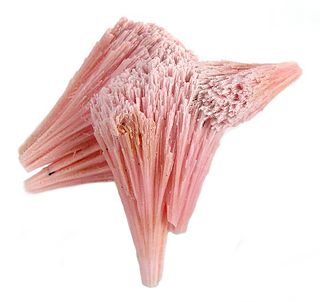
Kutnohorite is a rare calcium manganese carbonate mineral with magnesium and iron that is a member of the dolomite group. It forms a series with dolomite, and with ankerite. The end member formula is CaMn2+(CO3)2, but Mg2+ and Fe2+ commonly substitute for Mn2+, with the manganese content varying from 38% to 84%, so the formula Ca(Mn2+,Mg,Fe2+)(CO3)2 better represents the species. It was named by Professor Bukowsky in 1901 after the type locality of Kutná Hora, Bohemia, in the Czech Republic. It was originally spelt "kutnahorite" but "kutnohorite" is the current IMA-approved spelling.

Eosphorite is a brown (occasionally pink) manganese hydrous phosphate mineral with chemical formula: MnAl(PO4)(OH)2·H2O. It is used as a gemstone.
Zussmanite is a hydrated iron-rich silicate mineral with the chemical formula K(Fe2+,Mg,Mn)13[AlSi17O42](OH)14. It occurs as pale green crystals with perfect cleavage.
Coyoteite is a hydrated sodium iron sulfide mineral. The mineral was named coyoteite after Coyote Peak near Orick, California where it was discovered.
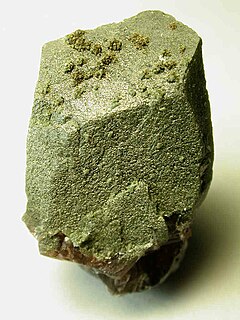
Chamosite is the Fe2+end member of the chlorite group. A hydrous aluminium silicate of iron, which is produced in an environment of low to moderate grade of metamorphosed iron deposits, as gray or black crystals in oolitic iron ore. Like other chlorites, it is a product of the hydrothermal alteration of pyroxenes, amphiboles and biotite in igneous rock. The composition of chlorite is often related to that of the original igneous mineral so that more Fe-rich chlorites are commonly found as replacements of the Fe-rich ferromagnesian minerals (Deer et al., 1992).

Fluor-liddicoatite is a rare member of the tourmaline group of minerals, elbaite subgroup, and the theoretical calcium endmember of the elbaite-fluor-liddicoatite series; the pure end-member has not yet been found in nature. Fluor-liddicoatite is indistinguishable from elbaite by X-ray diffraction techniques. It forms a series with elbaite and probably also with olenite. Liddiocoatite is currently a non-approved mineral name, but Aurisicchio et al. (1999) and Breaks et al. (2008) found OH-dominant species. Formulae are

Fluor-uvite is a tourmaline mineral with the chemical formula CaMg3(Al5Mg)(Si6O18)(BO3)3(OH)3F. It is a rare mineral that is found in calcium rich contact metamorphic rocks with increased amounts of boron. Uvite is trigonal hexagonal, which means that it has three equal length axes at 120 degrees, all perpendicular to its fourth axis which has a different length. Uvite is part of the space group 3m. Uvite's hardness has been measured to be 7.5 on the Mohs hardness scale. The color of uvite widely varies, depending on the sample, but is mostly deep green or brown. In regard to uvite's optical properties, it is uniaxial (-) and anisotropic, meaning that the velocity of light in the mineral depends on the path that it takes. In plane polarized light, uvite is colorless to pale yellow and shows weak pleochroism.
References
- 1 2 3 "Manganophyllite". www.mindat.org. Retrieved 2021-07-12.
- ↑ "MANGANOPHYLLITE | Definition of MANGANOPHYLLITE by Oxford Dictionary on Lexico.com also meaning of MANGANOPHYLLITE". Lexico Dictionaries | English. Archived from the original on July 12, 2021. Retrieved 2021-07-12.
- 1 2 3 "Bixybite and manganophyllite from Kajlidongri, India" (PDF). Mineralogical Magazine and Journal of the Mineralogical Society. 36: 295–296. 11 August 1966.
- 1 2 Nayak, V. K. (September 1961). "A note on Manganophyllite from Goldongri, India" (PDF). Mineralogical Magazine and Journal of the Mineralogical Society. 32 (254): 908–909. Bibcode:1961MinM...32..908N. doi:10.1180/minmag.1961.032.254.06. ISSN 0369-0148.
- 1 2 Levinson, A. A.; Heinrich, E. W M. (15 November 1953). "Single Crystal Data on Phlogopites, Biotites and Manganophyllites" (PDF). Studies in the Mica Group: 940–941.